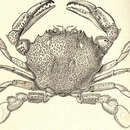fr
noms dans le fil d’Ariane


Ovalipes ocellatus, known as the lady crab, is a species of crab from eastern North America.[1] Other names for it include the leopard crab or Atlantic leopard crab due to the leopard-like rosette patterns on its shell, the calico crab (not to be confused with Hepatus epheliticus), or ocellated crab.[3] It has a shell 3 in (7.6 cm) long and only slightly wider, which is covered in clusters of purple spots. It occurs from Canada to Georgia, and lives mainly on molluscs, such as the Atlantic surf clam.
O. ocellatus was first described by Johann Friedrich Wilhelm Herbst in 1799, as Cancer ocellatus.[2] In 1898, Mary Jane Rathbun moved the species to her new genus Ovalipes.[4]
The carapace of O. ocellatus is slightly wider than long, at 8.9 centimetres (3.5 in) wide,[3] and 7.5 cm (3.0 in) long.[5] This distinguishes it from other crabs in the family Portunidae, which often have elongated lateral spines.[5] The carapace is yellow-grey[5] or light purplish,[3] with "leopardlike clusters of purple dots",[5] and 3–5 spines along the edge behind each eye.[3] O. ovalipes is almost identical to O. floridanus, which lives in the Gulf of Mexico, but can be separated from the sympatric O. stephensoni by the purple spots, which O. stephensoni lacks.[5]
The distribution of O. ocellatus extends from Canada to Georgia.[5] O. ocellatus is "probably the only Ovalipes species common north of Virginia", being replaced by Ovalipes stephensoni to the south.[6]
O. ocellatus has five larval stages, lasting a total of 18 days at 25 °C (77 °F) and a salinity of 30‰, and 26 days at 20 °C (68 °F) and 30‰.[7]
O. ocellatus is a nocturnal[5] predator,[3] which often buries itself in the sand.[3] It has been described as "vicious" and "the crab most likely to pinch a wader's toes".[5] It feeds mostly on molluscs, particularly the Atlantic surf clam Spisula solidissima.[8]
Ovalipes ocellatus, known as the lady crab, is a species of crab from eastern North America. Other names for it include the leopard crab or Atlantic leopard crab due to the leopard-like rosette patterns on its shell, the calico crab (not to be confused with Hepatus epheliticus), or ocellated crab. It has a shell 3 in (7.6 cm) long and only slightly wider, which is covered in clusters of purple spots. It occurs from Canada to Georgia, and lives mainly on molluscs, such as the Atlantic surf clam.
Ovalipes ocellatus is een krabbensoort uit de familie van de Polybiidae.[1] De wetenschappelijke naam van de soort is voor het eerst geldig gepubliceerd in 1799 door Herbst.
Bronnen, noten en/of referentiesOvalipes ocellatus é uma espécie de caranguejo da costa atlântica da América do Norte, onde é conhecido pelo nome comum de calico (não confundir com Hepatus epheliticus).[3] Tem uma carapaça com 7,6 cm de comprimento e ligeiramente mais larga, marcada por grupos de manchas púrpura. Ocorre do Canadá à Geórgia, alimentando-se principalmente de moluscos, em especial da ameijoa Spisula solidissima.
|acessodata= (ajuda) Ovalipes ocellatus é uma espécie de caranguejo da costa atlântica da América do Norte, onde é conhecido pelo nome comum de calico (não confundir com Hepatus epheliticus). Tem uma carapaça com 7,6 cm de comprimento e ligeiramente mais larga, marcada por grupos de manchas púrpura. Ocorre do Canadá à Geórgia, alimentando-se principalmente de moluscos, em especial da ameijoa Spisula solidissima.
Ovalipes ocellatus är en kräftdjursart som beskrevs av Johann Friedrich Wilhelm Herbst 1799. Ovalipes ocellatus ingår i släktet Ovalipes och familjen simkrabbor.
Den förekommer i Atlanten från Kanada till Georgia och livnär sig huvudsakligen på blötdjur som Spisula solidissima.[2]
Ovalipes ocellatus är en kräftdjursart som beskrevs av Johann Friedrich Wilhelm Herbst 1799. Ovalipes ocellatus ingår i släktet Ovalipes och familjen simkrabbor.
Den förekommer i Atlanten från Kanada till Georgia och livnär sig huvudsakligen på blötdjur som Spisula solidissima.